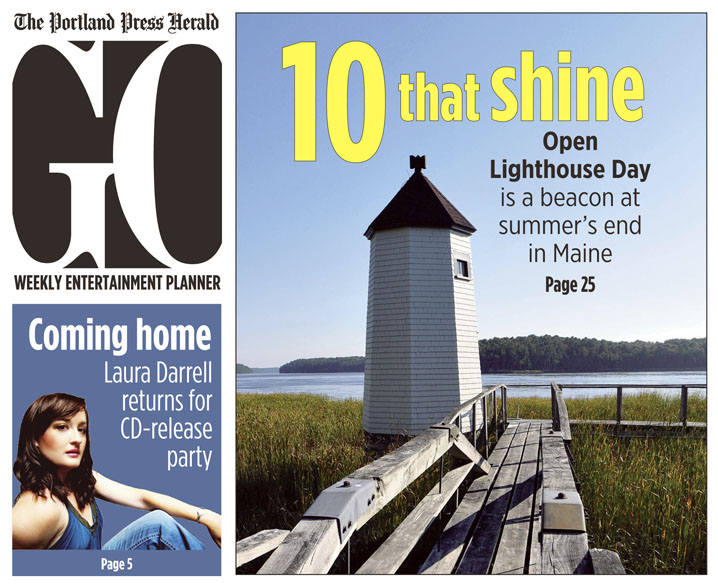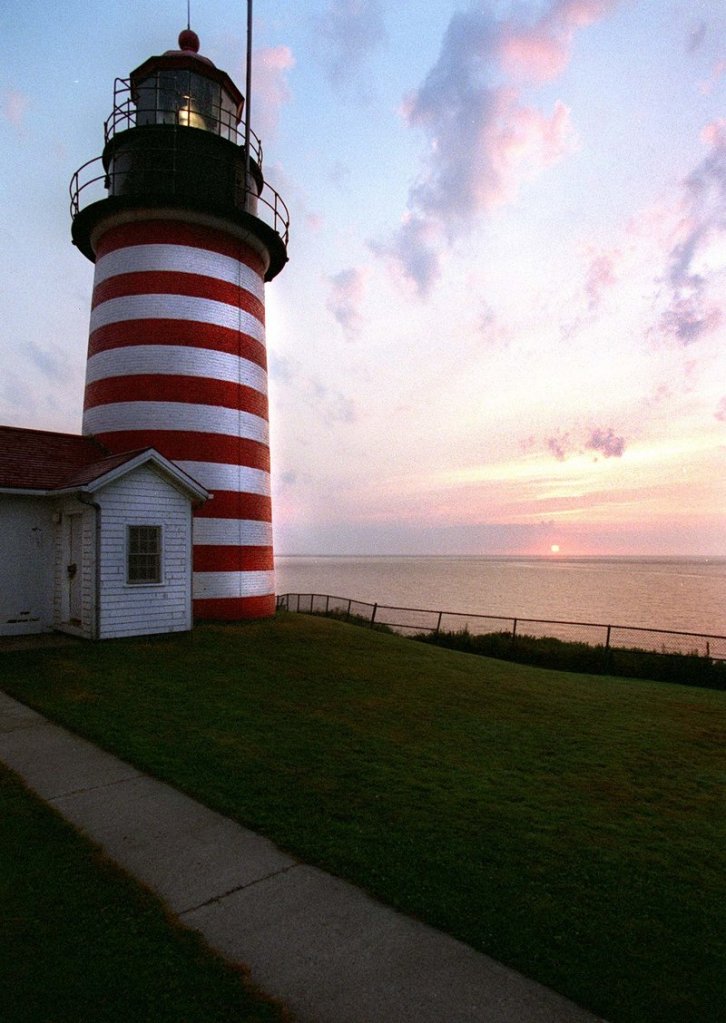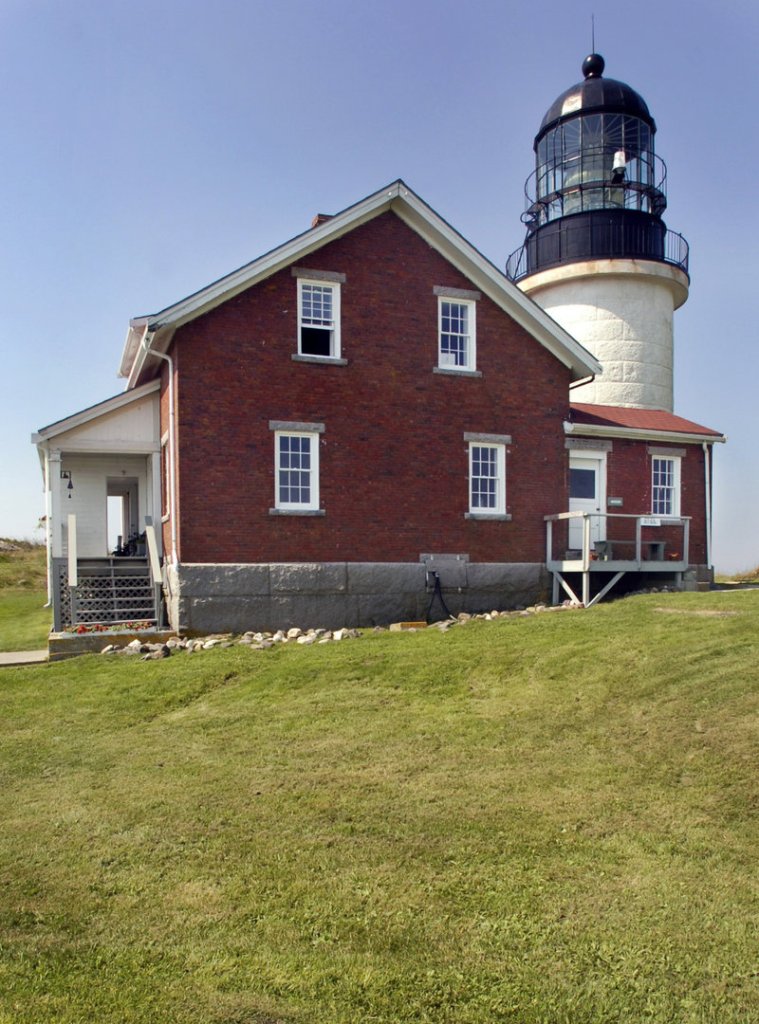Maine lighthouses have been keeping constant watch over the local coastline and its harbors since the 18th century (Portland Head Light in Cape Elizabeth holds the record). Lighthouse enthusiasts have been eyeballing those towers for almost just as long. These days, visitors arrive to admire the towers, marvel over the history and snap photos like lighthouse paparazzi.
During Saturday’s third annual Open Lighthouse Day, lighthouse fans will get some unprecedented access to 25 of those lights, some of which rarely open to the public. Each is unique in its own right, but here’s a roundup of some Maine lighthouses with extra-special backgrounds:
BURNT COAT HARBOR LIGHTHOUSE, Swan’s Island: This lighthouse might be struggling with a strange sensation that something’s missing. That’s because the light used to have a twin. It was built as part of a pair, but one was put out to pasture in 1884 after mariners complained that the duo was confusing. The tower that remains is uniquely square, and gets the job done just fine.
The island gets its name from Col. James Swan, whose previous endeavors included the Boston Tea Party. Swan sought out a little empire of his own and purchased the island and 23 others nearby in hopes of creating a feudal kingdom there — with him conveniently in the top spot. He ended up instead living the last 22 years of his life in a French prison.
KENNEBEC RIVER RANGE LIGHTS, Arrowsic: Historically, ships have had a hard time with unexpected 90-degree turns. And while some lighthouses are beacons that warn of shallow waters or a treacherous coastline, the set of lights known as the Kennebec River Range Lights guide ships through a tricky “S” turn on the Kennebec River. When the lights appear aligned one on top of the other, a mariner can be confident he’s maneuvering in the safe part of the channel.
Looking like gnomes of the lighthouse world with their white octagonal facades and pointed red roofs, the pair aren’t the most glamorous of Maine’s light stations. And they’re made of wood, which isn’t as fancy as the granite used by lighthouses down river. But they’re the last of their kind in Maine.
MARSHALL POINT LIGHTHOUSE, Port Clyde: Marshall Point Lighthouse is a looker. The scenic walkway leading to the 30-foot tower is an enticement itself, so it’s no wonder a scene from the 1994 movie “Forrest Gump” was filmed there. (Recall when Forrest just felt like running? Marshall Point Lighthouse is the eastern-most point he reaches before turning around to head back west again.)
There’s even a picture hanging in the lighthouse museum of Tom Hanks posing for the camera with a young Mainer during the scene’s filming. And for the record, people don’t usually run away from Marshall Point Lighthouse.
MONHEGAN ISLAND LIGHTHOUSE, Monhegan Island: It’s no secret that the lighthouse life wasn’t easy. Keepers and their families lived year-round in the shadow of their keep, diligently working through storms and seclusion.
But Betty Morrow Humphrey proved her own tenacity when she took over lighthouse keeper duties in 1862. Her husband fell ill and died, and two of her sons left to fight in the Civil War, leaving her with eight other children and a lighthouse to tend. But Humphrey stayed on until 1880.
OWLS HEAD LIGHTHOUSE, Owls Head: There are a few stories circulating in Maine about so-called “fog dogs.” The most popular seems to be Spot, the Springer spaniel companion of lighthouse keeper Augustus R. Hamor.
The dog was known to ring the fog bell by grabbing the bell’s rope with his teeth. He’d then run down to the water and bark until the boat was out of earshot. The rope-pulling pooch also reportedly helped a mail boat get safely home by barking through heavy snow and wind when the bell could not be rung. Spot was rightly buried near the lighthouse’s fog bell.
PORTLAND BREAKWATER LIGHTHOUSE (Bug Light), South Portland: Portland Breakwater Lighthouse — or “Bug Light” as locals know it — rests on the end of a breakwater 100 feet long. But it wasn’t always so close to shore. That breakwater originally stretched almost 2,000 feet into the harbor.
What is now Bug Light Park used to be open water, but the area was filled in during World War II to accommodate expanding shipyards. Before that, and before the keeper’s house was built precariously atop the breakwater, keepers were forced to crawl along the breakwater’s length in bad weather, or else risk getting knocked into the water by breaking waves.
The lighthouse was also modeled after the Choragic Monument of Lysicrates, a Greek monument erected in 300 B.C. to honor a prize-winning theatrical performance — a little bit of trivia to tell others while you’re standing in line on Saturday.
ROCKLAND BREAKWATER LIGHTHOUSE, Rockland: The thing about building a wall of granite that extends 4,346 feet into the harbor is that it becomes a bit of a hazard itself.
Waterfront buildings in Rockland were spared in bad weather thanks to the breakwater built in 1899, but ships were at risk of crashing into the 700,000 tons of stone. The lighthouse was built to give mariners a heads-up on the hazard. The almost-one-mile trek along the breakwater to get to the lighthouse was more effort than it was worth sometimes, and keepers found it easier to simply take a boat from Rockland Harbor. Now, it’s simply good scenic exercise.
SEGUIN ISLAND LIGHTHOUSE, Seguin Island: This lighthouse is known for being the highest tower in Maine, reaching 186 feet above sea level. The tower isn’t really that tall, but it’s lifted up with a little help from Seguin Island, which rises 150 feet out of the ocean.
Not as well known is where the name “Seguin” comes from. Some historians believe the name is a translation of the Indian word “Sutquin,” which means, “the place where the sea vomits,” a reference to the tumultuous waters. That visual doesn’t make the island or the lighthouse any less gorgeous.
WEST QUODDY HEAD LIGHTHOUSE, Lubec: Despite being called West Quoddy, the lighthouse actually rests on the easternmost point of the U.S. (East Quoddy Head Light is farther east in Canada.) It’s the only candy-striped lighthouse in Maine, its red and white stripes making it stand out boldly against the sky. They also make it look delicious.
WOOD ISLAND LIGHTHOUSE, Biddeford Pool: Just off the coast of Biddeford Pool, this lighthouse had more than its fair share of unfortunate incidents. A murder-suicide took place there after an island tenant drunkenly shot a special policeman/part-time lobsterman and then himself. Later, another man reportedly threw himself from a hotel window in Saco, not wanting to return to his isolated life on the island.
Wood Island was also once home to a French bootlegger who supplied booze to passing ships. Sometimes, the crewmen would buy some drink and hang out on the island for some oceanside revelry. One such evening, some drunken crewmen decided (for no obvious good reason) to burn down the bootlegger’s shack. The fire soon caught up to the building where the booze was made, and the leaping flames were apparently visible to ships 20 miles away.
During Open Lighthouse Day, guides will be available at each lighthouse to offer details about their past. And while all of them are fine to look at, it’s the history you can’t see that truly makes a lighthouse interesting.
Staff Writer Shannon Bryan can be contacted at 791-6333 or at:
sbryan@mainetoday.com
Twitter: mainetoday
Send questions/comments to the editors.





Comments are no longer available on this story